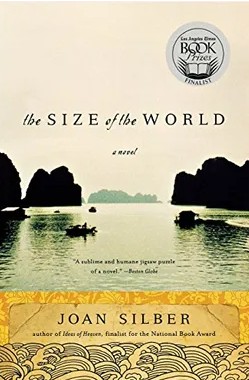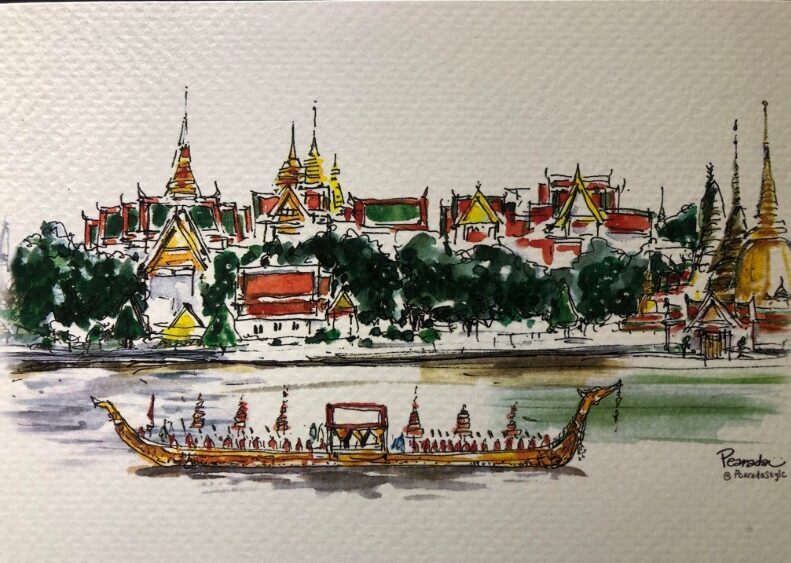The origin of this book on my nightstand is a bit of a mystery. It was published in 2008 and likely came into my possession within a couple of years after that. A lavender sticky note was attached to the front cover, it read: “Very good thread weave. Could have made going native look a little more fun and exciting.” An interesting expression – I cannot recall who gifted the book to me with this note as their personal mini-review.

The book is comprised of the first-person accounts of six individuals who describe their lives and loves and travels over the time period of decades, spanning the years from 1920 to present day. There is a common thread that all of the individuals have a personal connection to the country of Siam (Thailand) in some way; their lives intersect through time and place as the book progresses.
The opening chapter is narrated by Toby, a young engineer working for a military contractor, who travels overseas (with a co-worker, Ernst) to trouble shoot faulty airplane guidance systems in the midst of the Vietnam war. After this assignment is successfully completed, he has an R&R stopover in Bangkok, where he meets his eventual spouse, a Thai nurse named Toon. Soon after his repatriation he returns to marry Toon and becomes integrated into her extended family. The story captures the slow arc of his life from youth through the high school graduation of his oldest child. He has regrets for ongoing career setbacks but manages through with stoicism, and a stubborn dedication to family. Parallel with these same times his high school girlfriend Kit describes her own journey through adulthood, travel and relationships that do not end well. She begins: “For a while after I was married, my old boyfriend from high school used to send me letters from Vietnam. …His letters were cheerful in a petrified way…he was decent enough but arrogant and secretly frozen with everyday fears; I had always been a little too much for him. He thought I was crafty, but I was really just faster, in every sense.” She navigates through a failed marriage and relationships, a temporary relocation to a rural Mexico and raising her daughter (Phoebe) as a single mother. They both lament the lost opportunities of youth, and eventually they each make peace with the separate, imperfect arcs of their lives.
Corrinna is a daughter of the early sunbelt migration and subsequent land bust in 1920’s Florida, cast parentless and homeless by a storm to travel across the world in order to live with join her older brother Owen, who is a tin prospector in the far south of Siam. She is entranced by the country and the people – and enamored by a native Siamese prospector named Zain. Eventually she “settles” for an Englishman teacher to marry and start a family, returning again to Florida upon the start of World War 2. Upon arriving at her temporary house in southern Siam, she writes home to her best friend: “I am installed in my new abode! …Though I am not as good at sitting on the floor as I would like to think. My hours are my own…I like my regal solitude…In the cool of the morning I busy myself with walks – sometimes the tiny Som (the house cook) is my chaperone, and we walk as far as the harbor, for the pleasure of seeing the sea – on the way back we hear the calls to prayer at the mosque, and in the afternoon I try to teach myself Siamese from a book. They have forty-four consonants in their alphabet, which I think is too many. I read and I look at each tree and lizard in the garden and try (don’t shudder) to mentally describe it to my father. He would have liked it here.”

We meet Mike, a professor of history in the Midwest, in who after the breakup of his first marriage meets Vianna, the daughter of Annunziata, who emigrates to the U.S. from Sicily just after the end of the war in 1946. Annunziata: “I didn’t like America at first, how could I? We lived in a room in the half of the house my sister and her husband rented in Hoboken. The first few months I stayed mainly inside …I didn’t know how to act outside when people were speaking English.” Annunziata recounts the full story of reluctant immigration and eventual assimilation; she remains grounded with one foot in the old world even as her daughter Vianna embraces a modern approach to her own life; marrying a doctor who happens to be a grandson of long-ago Zain. She lives for several years in Bangkok before returning to the U.S. Her best friend in Bangkok was Toon, who cared for her after a car accident that killed her then husband.
Owen tells his own story of returning to the U.S. after the start of the great depression and eventually becoming a salesman for a screw manufacturer, crossing the country to San Francisco. He tries to assimilate to a single life, with one foot in the culture of east Asia and another on the roads of southwestern U.S., the life of a salesman. He unwittingly discovers the existence of defective screws in Vietnam warplane air guidance systems, and the story folds back on Toby again. Beginning and ending.
These stories weave together through time and place. The narrators each describe their personal adventures – often colored with loss and unfilled ambitions. The firsthand accounts are realistic and vivid in description; lives lived, loves lost, fortunes made and returned. The arc of time catches up with all of their interesting lives, though each touched with regrets for the passage of time.
I enjoyed the first-person perspective as it brought the characters fully to life. And the historical descriptions and details of life across decades in the U.S., Italy and Thailand, touched by world wars, regional wars, migration and societal change. Though limited to short travel stays, I have memorable personal connections to the countries of Thailand, Malaysia and Italy. The stories resonated with me, especially the descriptions and perspectives of the people of these wonderful countries.

Good writing takes you away from your routine life and broadens your horizons of time and place. I recommend that you take this trip, and consider reading other tiles by the author, Joan Silber. I will explore more of these, and report back.